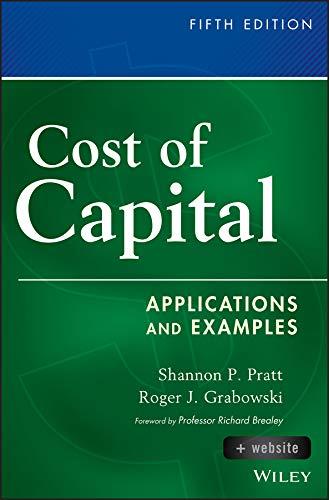Question
(30) For the sake of simplicity, assume that in each year, each company has a single investment opportunity to plow back some percentage of its
(30) For the sake of simplicity, assume that in each year, each company has a single investment opportunity to plow back some percentage of its earnings to generate annual cash ows at a rate equal to the its current return on book equity. (a) (10) For each company, consider the investment opportunity available next year (t = 1). Calculate the payback period, internal rate of return, and net present value NPV1 of next year's investment opportunity. Are these projects worth pursuing? (b) (10) Now consider each company's investment opportunity at t = 2, with annual earnings permanently increased by the cash ows from the year 1 investment. If the rm continues to plow back the same proportion of earnings and earns the same return on equity, what is the net present value NPV2 of the project? (c) (10) If each company continued to plow back earnings at the same rate and earn the same return on equity, what would be the present value of all its future growth opportunities? Does this match your answer from #1?

SignWindow Help AS 440 640 Assig.. AS_440_640_Assig- X 1 / 1 115% TC (IV) Tor eact SLOCK, calculate the market capitanzation rate, and break WOWI the snare price mo me level earnings and growth opportunities components. 2. (30) For the sake of simplicity, assume that in each year, each company has a single investment opportunity to plow back some percentage of its earnings to generate annual cash flows at a rate equal to the its current return on book equity. (a) (10) For each company, consider the investment opportunity available next year (t = 1). Calculate the payback period, internal rate of return, and net present value N PV1 of next year's investment opportunity. Are these projects worth pursuing? (b) (10) Now consider each company's investment opportunity at t = 2, with annual earnings permanently increased by the cash flows from the year 1 investment. If the firm continues to plow back the same proportion of earnings and earns the same return on equity, what is the net present value N PV2 of the project? (c) (10) If each company continued to plow back earnings at the same rate and earn the same return on equity, what would be the present value of all its future growth opportunities? Does this match your answer from #1? 40) We will now analyze the historical returns of your chosen stocks. You may choose any time period and requency you deem suitable, but make sure that all of your returns are reported as annualized rates. You will want to use the adjusted closing price to automatically account for the effects of dividends and splits. a) (10) For each stock as a well as a suitable market index, report the mean and standard deviation of returns (10) Find the variance-covariance matrix of the two stocks and the market index, and report the beta of SignWindow Help AS 440 640 Assig.. AS_440_640_Assig- X 1 / 1 115% TC (IV) Tor eact SLOCK, calculate the market capitanzation rate, and break WOWI the snare price mo me level earnings and growth opportunities components. 2. (30) For the sake of simplicity, assume that in each year, each company has a single investment opportunity to plow back some percentage of its earnings to generate annual cash flows at a rate equal to the its current return on book equity. (a) (10) For each company, consider the investment opportunity available next year (t = 1). Calculate the payback period, internal rate of return, and net present value N PV1 of next year's investment opportunity. Are these projects worth pursuing? (b) (10) Now consider each company's investment opportunity at t = 2, with annual earnings permanently increased by the cash flows from the year 1 investment. If the firm continues to plow back the same proportion of earnings and earns the same return on equity, what is the net present value N PV2 of the project? (c) (10) If each company continued to plow back earnings at the same rate and earn the same return on equity, what would be the present value of all its future growth opportunities? Does this match your answer from #1? 40) We will now analyze the historical returns of your chosen stocks. You may choose any time period and requency you deem suitable, but make sure that all of your returns are reported as annualized rates. You will want to use the adjusted closing price to automatically account for the effects of dividends and splits. a) (10) For each stock as a well as a suitable market index, report the mean and standard deviation of returns (10) Find the variance-covariance matrix of the two stocks and the market index, and report the beta of
Step by Step Solution
There are 3 Steps involved in it
Step: 1

Get Instant Access to Expert-Tailored Solutions
See step-by-step solutions with expert insights and AI powered tools for academic success
Step: 2

Step: 3

Ace Your Homework with AI
Get the answers you need in no time with our AI-driven, step-by-step assistance
Get Started


